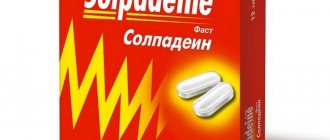Causes of vascular headache development
Vegetative-vascular dystonia is an outdated name for autonomic dysfunction of the cardiovascular system. VSD is characterized by more than 150 symptoms, the most common of which is vascular headache.
The causes of headaches are:
- decreased tone of the blood vessels supplying the brain, which causes hypoxia (usually occurs with a systematic increase in pressure, which stretches the walls of blood vessels),
- pressure on nerve bundles specifically at the moment of a pressure surge (expansion of the walls of blood vessels),
- venous congestion and cerebral edema,
- arterial spasm.
Symptoms of headache with vegetative-vascular dystonia
The symptoms of vascular headaches are very diverse, but the main difference from other types of pain is less intensity, rather “background” pain, but painful attacks, for example, migraines, can also occur.
- Headache with VSD accompanies a person constantly with varying intensity. She goes away during sleep, but returns within the first minutes after waking up. Due to the “background” course of pain, it often begins to be perceived as a normal condition. But if you ask such a patient if he has a headache, he will always answer “yes.”
- The pain with VSD is “dull.” It can be squeezing, bursting, pulsating, etc. Its intensity is low (except for attacks, which are also “dull”, although strong), therefore, if the patient complains of acute pain, this most likely will not be VSD.
- A constant headache slightly disrupts the perception of reality: sounds may seem muffled, the movements of the surrounding world are inhibited and excessively smooth. This condition can be dangerous for a person, as he may inadequately assess the situation and, for example, get hit by a car.
- Vascular headache is often accompanied by other vegetative manifestations and neurological conditions: dizziness, unsteadiness of gait and difficulties with balance and coordination of movements, fainting, drowsiness, weakness, nausea, tinnitus, “stars” before the eyes, increased sweating (especially of the palms).
- The pain may intensify when bending over, which once again proves its vascular origin.
- The localization can be absolutely any: the entire head, one half of the head, a “hoop” at the level of the forehead, only the forehead/temples/back of the head/vertex/eye sockets, with irradiation to the ear or neck.
- The nature of the pain is usually aching, squeezing or, conversely, bursting, often pulsating (not necessarily in time with the heartbeat).
- Painkillers are usually ineffective for vascular pain. In some cases, antispasmodics help.
Often, exacerbations of headaches occur during periods of intense and prolonged mental activity, strong emotional stress, physical overload, weather and climate changes, etc. Read more about the causes and symptoms of VSD here.
Headache due to vascular diseases
07/06/19
There is probably not a single adult who is not bothered by a headache. There are many children who suffer from headaches. Headache most often manifests itself in such common diseases as hypertension, cerebral vascular diseases (atherosclerosis, congenital vascular diseases), migraine, etc. Headache is a manifestation of various changes in the brain, including its membranes and blood vessels, and always requires special research to determine the causes of its occurrence.
Headache due to vascular diseases
Sometimes the nature and location of the headache can determine its cause. Pain in the occipital region of the head is most often caused by increased blood pressure or spinal disease. Pain on one half of the head occurs more often with migraines, and the frontal part of the head is observed with diseases of the paranasal sinuses and organs of vision. Morning headaches are often associated with increased intracranial pressure. The appearance of headaches at the end of the working day is often associated with overwork. Let's talk about vascular diseases as a cause of headaches.
If treatment for headaches is ineffective, think about whether you have diseases of the great vessels that supply the brain. These include: atherosclerosis, tortuosity (up to looping), aneurysm and others.
In healthy people, blood flows freely through the arteries to all organs and tissues, supplying them with oxygen and other nutrients. With atherosclerosis, a fatty substance called cholesterol is deposited on the inner wall of the arteries. A “growth” forms on the inner wall of the vessel - an atherosclerotic plaque, narrowing the lumen of the vessel and disrupting blood flow in the organ. Oxygen starvation develops in the organ that receives blood from the affected artery. With atherosclerosis, the arteries of the heart are also affected - chronic ischemic heart disease develops (its clinical manifestation can be chest pain, arrhythmias, heart failure). As a rule, the provocative moment of this condition is headache. With a pronounced narrowing of the vessel supplying the brain, chronic insufficiency of blood supply to the brain occurs. Its outcome is a stroke. Stroke is the second most common killer of people.
A characteristic feature of headaches with vascular damage is its persistence. Headaches with damage to the blood vessels of the brain are often accompanied by dizziness, loss of memory, unsteady gait, the appearance of dark “spots” in the eyes, numbness of the limbs, fatigue, nervousness, poor sleep, and noise in the head. Risk factors for the development of atherosclerosis include: high blood pressure, stressful lifestyle, physical inactivity, smoking, obesity, diabetes, heredity.
If you suffer from a headache, you suffer from atherosclerosis, hypertension, there are the above risk factors, if you value your health, if you do not want the sad statistics of stroke victims to increase at your expense - act now! Stroke is easier to prevent than to treat! Today medicine is ready to successfully combat the pathology of the great vessels.
Visit a neurologist, cardiologist, ophthalmologist! After a conversation with you and a medical examination, the doctor will prescribe the necessary diagnostic, therapeutic and preventive measures, and then refer you to a vascular surgeon. The main method for diagnosing diseases of the vessels that supply the brain is ultrasound diagnostics (ultrasound of the vessels of the neck), with which it is possible to detect vascular damage. The huge advantage of this diagnosis is its accuracy and the ability to perform it on an outpatient basis. In addition, ultrasound diagnostics provides information about damage to the aorta and great arteries, even in cases where there are no clinical signs of a particular disease. This diagnostic method is especially indispensable when identifying congenital vascular pathology in children, and they, too, can have headaches.
Along with ultrasound diagnostic methods, there are now other methods for detecting vascular damage. These are magnetic resonance angiography, electron beam tomography and a number of others. But all of them are based on the use of expensive devices and cannot be applied on a mass scale. The unclear cause of the headache, the abundance of advertisements in the media for medications and dietary supplements with instructions for their use, and home physiotherapeutic devices - all this delays the time of a patient’s visit to a vascular surgeon when there are already obvious signs of the disease. The result is that doctors continue to treat, patients continue to get sick. Knowing the cause of your suffering associated with vascular disease, you can contact a vascular surgeon in time, get the opportunity to restore normal patency of the vascular bed, get rid of headaches, and prevent a terrible complication - a stroke.
Today, along with the development of new diagnostic techniques, improvement of surgical techniques, including endovascular (intravascular), methods of protecting the brain from ischemia, indications for surgical treatment have been clarified. The question of indications for surgical treatment is decided only by a vascular surgeon, taking into account the patient’s examination data from other specialists (neurologist, cardiologist).
I hope that together we will try to solve the problem of headaches due to vascular diseases.
Diagnosis of headache due to VSD
A headache can occur in many cases and for various reasons, so it is very important to carry out a differential diagnosis of vascular headache:
- magnetic resonance or computed tomography (to exclude tumors, stroke, vascular malformation, consequences of traumatic brain injury, etc.), electroencephalography,
- X-ray of the head and cervical spine (to exclude sinusitis, skull injuries, displacement of the cervical vertebrae),
- vascular doppler,
- neurological examination (palpation of the neck and shoulder girdle, neurological tests),
- blood tests.
If you suffer from frequent headaches, you need to visit a neurologist who will prescribe the necessary tests and select adequate treatment.
Headache and its causes
All people have experienced headaches at least once.
Often, we put off visiting a specialist for as long as possible. However, it is important to remember that headaches can be a symptom of serious diseases, and the earlier the diagnosis is made, the more favorable the prognosis and the more effective the treatment. The most common causes of headaches are:
- Tension headaches are most often caused by muscle spasms that occur against the background of chronic stress, lack of physical activity, and a sedentary lifestyle.
- Migraine is a form of headache manifested by intense attacks (usually unilateral), accompanied by various neurological, autonomic and gastrointestinal manifestations. This type of headache often debuts in childhood and adolescence, with periods of remissions and exacerbations.
- Cluster headache – this type of pain is localized in one area (cluster) of the head, has high intensity, is accompanied by lacrimation, rhinorrhea, and redness of the eye.
- Vertebrogenic headache is pain caused by osteochondrosis of the cervical spine, with reflex involvement of the muscles of the upper shoulder girdle and neck.
- Isolated neuralgia of individual nerves (facial, trigeminal, occipital), acute inflammatory disease of the type of inflammation of one nerve, against the background of an infectious process, metabolic disorders, pinched nerve along its route. This type of pain is accompanied by sharp, highly intense pain lasting several seconds.
- Headaches of vascular origin are often chronic and of moderate intensity. It may be due to the peculiarities of the anatomical development of the vessels of the neck and brain.
- Headache caused by concomitant pathology. Quite often, headaches are symptomatic. May be a sign of cardiac pathology (decompensated hypertension), ENT pathology (otitis, sinusitis, frontal sinusitis), dental pathology (dysfunction of the temporomandibular joint, inflammatory diseases of the dentition), endocrinological pathology (dishormonal disorders).
- For the first time, unbearable headaches may be caused by the development of a stroke or rupture of a cerebral aneurysm. In this case, the patient requires immediate hospitalization.
Treatment of vascular headache and prevention of VSD
There is no actual treatment for vascular headache, i.e. It is extremely difficult to stop an attack of pain. Therapeutic measures are aimed at increasing vascular tone, restoring normal blood circulation to the brain and improving the functioning of the cardiovascular system. Read more about the treatment of vegetative-vascular dystonia and specifically headaches at the Aximed neurology clinic “here”.
In addition to drug treatment for people suffering from headaches and other symptoms of VSD, Aximed neurologists recommend:
- eliminate stressful situations from your life as much as possible (change jobs, undergo a course of family psychotherapy, etc.),
- maintain a sleep/wake and work/rest schedule,
- stop smoking (this constricts blood vessels and weakens the elasticity of the walls),
- eat a complete and balanced diet,
- Jogging is highly recommended, since in the process the brain is actively saturated with oxygen (which may be lacking due to reduced blood supply to the brain),
- massages (especially the collar area).
Are you plagued by headaches? Consult a neurologist. Vegetative-vascular dystonia can be treated, but the more advanced the case, the longer it will take, and the more likely it is that the pain will return again. Do not delay treatment, because life without pain is much more pleasant.
Vascular diseases: signs and treatment
22.10.2019
How can you help your blood vessels be healthy? What diseases are there that are common lately? The answer to this question is in this article.
A person lives and does not notice how his arteries and veins throughout the body help to supply nutrients and oxygen to the organs. Vascular diseases in our time, unfortunately, are one of the main causes of mortality. More often these problems occur in children and adolescents.
What diseases do blood vessels have?
Doctors divide types of vascular diseases according to their location; they find the source of the disease. If the central nervous system , then this disrupts blood circulation in the aortas and arteries of various parts of the body. Symptoms of different ailments may be different.
Atherosclerosis
This dangerous disease is quite insidious. Its main cause is “bad” cholesterol. It accumulates in the body with increasing consumption of junk food. Lead to atherosclerosis : diabetes , hypertension , obesity , bad heredity, bad habits.
Symptoms may vary. If we are talking about heart , then pain is usually noticeable in the left side of the chest , radiating to the arm. heart rhythm disturbances , weakness in the legs and arms, and possible fainting. With atherosclerosis dizziness and a burning sensation in the chest occur . If the abdominal region suffers, then problems appear with the gastrointestinal tract, kidneys abdominal pain . There are of atherosclerosis .
Ischemia
This disease occurs when there is insufficient blood in certain vessels that supply the myocardium and brain . Excessive exercise and stress can be its cause. In any case, it disrupts the body's carbohydrate-fat metabolism.
If a person has chest pain radiating to the arm, shortness of breath, arrhythmia, rapid pulse - this may be an indicator of ischemic diseases.
Strokes
A most insidious illness that has often appeared in people lately. Occurs from impaired blood supply to brain . In the process, nerve endings may die and their functions may deteriorate. At first, the symptoms are not noticeable. But if you have weakness and numbness in your arms and legs , as well as a throbbing headache, possible double vision and nausea your doctor immediately .
Hypertension
It seems something normal and not so scary. But symptoms such as pain in the back of the head, in the temples, tinnitus and dark spots before the eyes , dizziness , swelling of the limbs and nausea doctor about your condition . Otherwise hypertension , hypertension can lead to complicated diseases.
VSD
The development of VSD - vegetative-vascular dystonia - is observed when there is a malfunction in the functioning of the nervous system and weakening of blood vessels. insomnia can lead to this - all this is the cause of this disease.
Varicose veins
This is also not such a simple, although common, ailment. It is noticeable when venous patterns appear on the legs , but begins much earlier. If a person has bad heredity, he leads an incorrect lifestyle - all this can affect the blood vessels of the legs . Venotonics and compression garments can help, but this cannot be done without the advice of a doctor .
Diagnostics related to blood vessels
Once again it is worth recalling that only a doctor . An ordinary person may not understand the course of a particular disease and may prescribe the wrong and sometimes harmful medications to himself.
If you see a doctor , he will most likely prescribe a clinical blood . In some cases, biochemical and immunological tests, coagulogram, vascular angiography, ultrasound , MRI or RVG of vessels are also indicated.
It must be remembered that possible complications from vascular diseases are common and unpleasant, so consult a good doctor .
Remedies against vascular diseases
To treat vascular diseases, doctors use various drugs: myotropic and neurotropic drugs, blockers, cardiac drugs, drugs with nicotinic acid and others. But doctors remind: you need to eat right. To do this, you need to prepare dishes from cereals , bran, vegetable oils (especially olive), sea fish and seafood. Biscuits, bread, light vegetable or meat soups, nuts, legumes, seasonal berries and fruits are also useful. Doctors ask you to pay attention to the fact that you need to eat seasonal vegetables and fruits.
You also need to manage stress, regularly measure your blood pressure, take walks, have a hobby, do yoga and Pilates.
Published in Cardiology Premium Clinic







